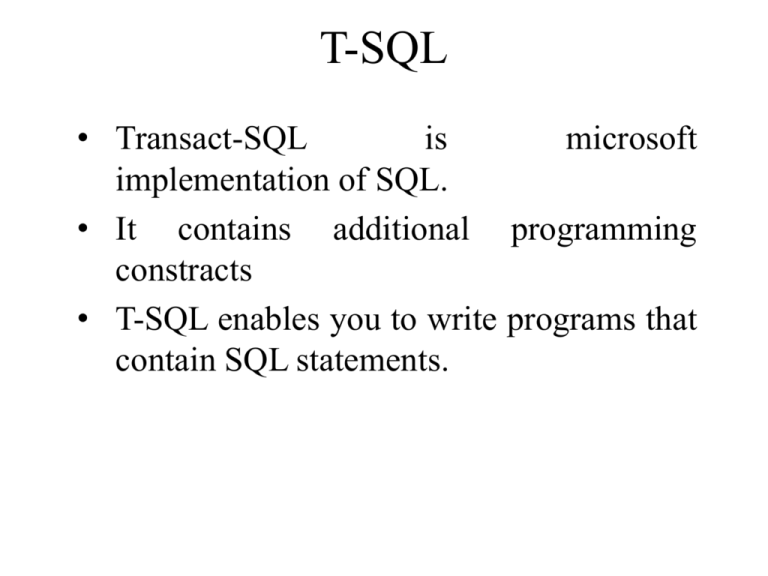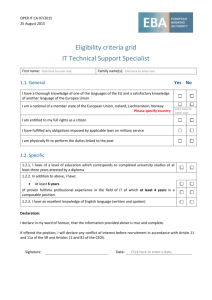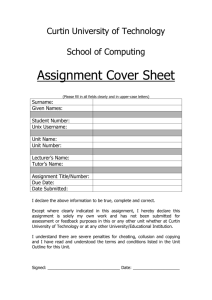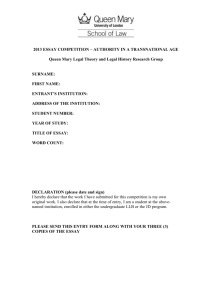T_SQL
advertisement

T-SQL
• Transact-SQL
is
microsoft
implementation of SQL.
• It contains additional programming
constracts
• T-SQL enables you to write programs that
contain SQL statements.
Using Variables
• You can declare variable using
DECLARE statement, followed by the
variable name and the type
DECLARE @name type
For example
DECLARE @MyProductName nvarchar(40)
DECLARE @MyProductId int
Using Variables
• Variables are initially set to null.
• You set a variables’ value using SET statement
SET @MyProductName= ‘Chai’
SET @MyProductID = 7
The following SELECT statement uses these
variables:
Select ProductId, ProductName, UnitPrice
From Products
Where ProductId=@MyProductID OR
ProductName=@MyProductName
Using Conditional Logic
• T-SQL enables you to use conditional logic
operaters in SQL stataments.
• IF-then-ELSE
IF conditon
statement 1
ELSE
statement 2
You can replace a single statement with multiple
statements by placing those statements within BEGIN
and END statements
Using Conditional Logic
If (Select Count(*) from products where unitprice<5)>0
BEGIN
Print ‘The following products have a UnitPrice of less than 5’
Select ProductId, ProductName, UnitPrice
From Products
Where UnitPrice<5
END
Else
BEGIN
Print ‘There are no products that have a UnitPrice of less than 5’
END
Using CASE Statement
The following example uses a select statement to retrieve
the value Massachusetts returned by the case statement:
Declare @State nchar(2)
Set @State =‘MA’
Declare @StateName nvarchar(15)
Select Case @State as State
When ‘CA’ then ‘California’
When ‘MA’ then ‘Massachusetts’
When ‘NY’ then ‘New York’
End
Using CASE Statement
You can store the value retrived by the SELECT statement in a variable
as shown in the example
Declare @State nchar(2)
Set @State =‘MA’
Declare @StateName nvarchar(15)
Select @StateName=
Case @State
When ‘CA’ then ‘California’
When ‘MA’ then ‘Massachusetts’
When ‘NY’ then ‘New York’
End
Print @StateName
Using CASE Statement
You can also compare a column value in a CASE
statement
Select Price=
Case
When UnitPrice is NULL then 'Unknown'
When UnitPrice <10 then 'Less than 10'
When UnitPrice =10 then '10'
Else 'Greater than 10'
End
From Products
While Loops
While conditon
statement
The following example shows a while loop:
Declare @count int
Set @count = 5
While (@count>0)
Begin
Print ‘count=’ + convert(nvarchar,@count)
Set @count=@count-1;
End
Continue Statement
You can use the Continue statement to start a next iteration of while loop
immediately, skipping over any remaining code in the loop.
Declare @count int
Set @count = 5
While (@count>0)
Begin
Print ‘count=’ + convert(nvarchar,@count)
Set @count=@count-1;
if (@count=2)
Begin
Set @count=@count-1;
Continue
end
End
Break Statement
Declare @count int
Set @count = 5
While (@count>0)
Begin
Print ‘count=’ + convert(nvarchar,@count)
Set @count=@count-1;
If (@count=2)
Begin
Break
End
End
Using Labels and the Goto Statement
You use the Goto statement to jump a specified label in your code;
you use a label to identify a statement of your code.
Declare @count int
Set @count = 5
myLabel:
Print ‘count=’ + convert(nvarchar,@count)
Set @count=@count-1;
If (@count>0)
Begin
GOTO myLabel
End
Output of these code is the same with the while loop’s output
Using Waitfor Statement
There are times when you want your program
to pause before running some code to perform
a specific action, such as running a batch
program at night to update customer records
WAITFOR {DELAY ‘ time interval’ | TIME
‘actual time’}
Waitfor Delay ‘00:00:05’ waits for a time
interval of 5 seconds
Using Waitfor Statement
Using WAITFOR TIME: The following example executes
the stored procedure sp_update_job at 10:20 P.M. (22:20).
USE msdb;
EXECUTE sp_add_job @job_name = 'TestJob';
BEGIN
WAITFOR TIME '22:20';
EXECUTE sp_update_job @job_name = 'TestJob',
@new_name = 'UpdatedJob';
END;
GO
Using Waitfor Statement
Using WAITFOR DELAY: The following
example executes the stored procedure after a
two-hour delay.
BEGIN
WAITFOR DELAY '02:00';
EXECUTE sp_helpdb;
END;
GO
Using Raiserror Statement
• You use the Raiserror statement to generate
an error message.
• It is typically used to if an error is occurs in
one of your stored procedures.
Syntax:
RAISERROR({number | description}{, severity, state})
• Number is error number and between 50,001 and
2,147,483,648
• Description is the error message
• Severity is the degree of the error and between 0 and 18
Using Raiserror Statement
•
The following code example shows how to use RAISERROR inside a TRY block to cause
execution to jump to the associated CATCH block. It also shows how to use RAISERROR
to return information about the error that invoked the CATCH block.
BEGIN TRY
-- RAISERROR with severity 11-19 will cause execution to
-- jump to the CATCH block.
RAISERROR ('Error raised in TRY block.', -- Message text.
16, -- Severity.
1 -- State.
);
END TRY
BEGIN CATCH
DECLARE @ErrorMessage NVARCHAR(4000);
DECLARE @ErrorSeverity INT;
DECLARE @ErrorState INT;
SELECT
@ErrorMessage = ERROR_MESSAGE(),
@ErrorSeverity = ERROR_SEVERITY(),
@ErrorState = ERROR_STATE();
-- Use RAISERROR inside the CATCH block to return error
-- information about the original error that caused
-- execution to jump to the CATCH block.
RAISERROR (@ErrorMessage, -- Message text.
@ErrorSeverity, -- Severity.
@ErrorState -- State.
);
END CATCH;
Using Cursor
• When you execute a SELECT statement, all
the effected rows are returned in one go.
• Sometimes you might want to take some
action based on the column values retrived
for a particular row.
• To do this, you can use a cursor to process
rows retrived from the database one row at a
time.
Using Cursor
You follow these steps when using a cursor:
• Declare Variables to Store the Column Values from
the Select Statement
•
•
These variables must be compatible with the column
types for the retrieved rows.
Example:
DECLARE @MyProductID int
DECLARE @MyProductName nvarchar (40)
DECLARE @MyUnitPrice money
Using Cursor
• Declare the Cursor
•
•
•
A cursor declaration consists of a name that you assign
to the cursor and a SELECT statement that you want to
execute retrieved rows.
This SELECT statement is not actually run until you
open the cursor.
Example:
DECLARE ProductCursor CURSOR for
Select ProductID, ProductName, UnitPrice
from Products
Where ProductID<=10
Using Cursor
•
•
Open the Cursor
You open a cursor using the OPEN statement.
OPEN ProductCursor
Fetch the Rows from the Cursor
• To read each row from your cursor, use the fetch statement
• Since there might be many rows, you need to usee While loop.
• To check end of loop, use @@FETCH_STATUS function. This
function returns:
• 0 if FETCH statement successfully returned a row.
• -1 if FETCH statement failed or the requested row is
outside the result set.
• -2 if Row fetched is missing
Using Cursor
The following example shows a loop that reads each row from ProductCursor.
Fetch Next from ProductCursor
Into @MyProductID, @MyProductName, @MyUnitPrice
Print ‘@MyProductID=‘ + Convert (nvarchar, @MyProductID)
Print ‘@MyProductName=‘ + Convert (nvarchar, @MyProductName)
Print ‘@MyUnitPrice=‘ + Convert (nvarchar, @MyUnitPrice)
While @@Fetch_Status=0
Begin
Fetch Next from ProductCursor
Into @MyProductID, @MyProductName, @MyUnitPrice
Print ‘@MyProductID=‘ + Convert (nvarchar, @MyProductID)
Print ‘@MyProductName=‘ + Convert (nvarchar, @MyProductName)
Print ‘@MyUnitPrice=‘ + Convert (nvarchar, @MyUnitPrice)
END
Using Cursor
• Close the Cursor
You close a cursor using the CLOSE statement.
CLOSE ProductCursor
You should also remoce the reference to your curs
or using the DEALLOCATE statement.
DEALLOCATE ProductCursor
Functions
• There are many built-in functions to use in TSQL.
• You can find detailed explanation about these
functions from the web site below:
http://msdn.microsoft.com/enus/library/ms174318.aspx
Creating User-Defined Functions
• You create a function using the CREATE
FUNCTION statement.
• There are three types of user-defined functions:
•
•
•
Scalar Functions: These functions returns a single
value.
Inline Table-valued Functions: Returns an object of
the table type. You can think of a table a a regular
database table, except it is stored in memory. An
inline table-valued function can return the results
retrived by only a single SELECT statement.
Multistatement table-valued Function: Returns a
object of table type and it can contain multiple TSQL statement.
Creating User-Defined Functions
Scalar Functions: The example below creates the DiscountPrice()
function, which returns the original price of an item multipled by a
discount factor.
Create Function DiscountPrice(@OriginalPrice money, @Discount money)
Returns Money
As
Begin
Return @OriginalPrice * @Discount
End
Using this function:
Declare @MyDiscountFactor Float
Set @MyDiscountFactor =0.3
Select dbo.DiscountPrice(UnitPrice,@MyDiscountFactor ), UnitPrice
From Products
Where ProductID=1
Creating User-Defined Functions
Inline Table-Valued Functions: Inline userdefined functions are a subset of user-defined
functions that return a table.
Inline functions can be used to achieve the
functionality of parameterized views.
Consider this view:
CREATE VIEW vw_CustomerNamesInWA AS
SELECT CustomerID, CompanyName
FROM Northwind.dbo.Customers
WHERE Region = 'WA'
Creating User-Defined Functions
Inline Table-Valued Functions: You can
create a more generalized version,
vw_CustomerNamesInRegion, by replacing
the WHERE Region = 'WA' with a WHERE
Region = @RegionParameter and letting
users specify the region they are interested
in viewing. Views, however, do not support
parameters in the search conditions
specified in the WHERE clause.
Creating User-Defined Functions
CREATE FUNCTION fn_CustomerNamesInRegion
( @RegionParameter nvarchar(30) )
RETURNS table
AS
RETURN (
SELECT CustomerID, CompanyName
FROM Northwind.dbo.Customers
WHERE Region = @RegionParameter
)
-- Example of calling the function for a specific region
SELECT *
FROM fn_CustomerNamesInRegion(N'WA')
Creating User-Defined Functions
Inline user-defined functions follow these rules:
•
The RETURNS clause contains only the keyword table. You
do not have to define the format of a return variable because it
is set by the format of the result set of the SELECT statement
in the RETURN clause.
•
There is no function_body delimited by BEGIN and END.
•
The RETURN clause contains a single SELECT statement in
parentheses. The result set of the SELECT statement forms the
table returned by the function. The SELECT statement used in
an inline function is subject to the same restrictions as
SELECT statements used in views.
•
The table-valued function
@local_variable arguments
accepts
only
constants
or
Creating User-Defined Functions
Inline Table-Valued Functions: The example below creates the
ProductsToBeReordered() function, which returns a table containing the rows
from the Products table
Create Function ProductsToBeReordered (@ReorderLevel int)
Returns Table
As
Return
(
Select *
From Products
Where UnitsInStock<=@ReorderLevel
)
Using this function:
Select ProductID, ProductName, UnitsInStock
From ProductsToBeReordered(10)
Where ProductId<=50;
Creating User-Defined Functions
Multistatement Table-Valued Functions: User-defined functions that return a table
can be powerful alternatives to views. A user-defined function that returns a table
can be used where table or view expressions are allowed in Transact-SQL
queries. While views are limited to a single SELECT statement, user-defined
functions can contain additional statements that allow more powerful logic than is
possible in views.
In a user-defined function that returns a table:
• The RETURNS clause defines a local return variable name for the table
returned by the function. The RETURNS clause also defines the format of the
table. The scope of the local return variable name is local within the function.
• The Transact-SQL statements in the function body build and insert rows into
the return variable defined by the RETURNS clause.
• When a RETURN statement is executed, the rows inserted into the variable
are returned as the tabular output of the function. The RETURN statement
cannot have an argument.
Creating User-Defined Functions
This example creates a function in the Northwind database that returns a table:
CREATE FUNCTION LargeOrderShippers ( @FreightParm money )
RETURNS @OrderShipperTab TABLE
(
ShipperID int,
ShipperName nvarchar(80),
OrderID
int,
ShippedDate datetime,
Freight
money
)
AS
This query references the table
BEGIN
returned by the function in its
INSERT @OrderShipperTab
FROM clause:
SELECT *
SELECT S.ShipperID, S.CompanyName,
FROM LargeOrderShippers( $500 )
O.OrderID, O.ShippedDate, O.Freight
FROM Shippers AS S INNER JOIN Orders AS O
ON S.ShipperID = O.ShipVia
WHERE O.Freight > @FreightParm
RETURN
END
Creating User-Defined Functions
Multistatement Table-Valued Functions: The example below creates the
ProductsToBeReordered2() function, which returns a table containing the rows
from the Products table
Create Function ProductsToBeReordered2 (@ReorderLevel int)
Returns @MyProducts table
(
ProductID int, ProductName nvarchar(40), UnitsInStock smallint, Reorder nvarchar(3)
)
As
Begin
Insert into @MyProducts
Select ProductID, ProductName, UnitsInStock, ‘no’ from Products
Update @MyProducts
Set Reorder=‘yes’
Where UnitsInStock<=@ReorderLevel
Return
End
Usage of the function
Select * from ProductsToBeReordered2(20)






